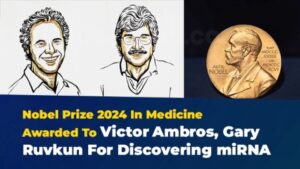Victor Ambros and Gary Ruvkun, two American scientists, have been handed the 2024 Nobel Prize in Physiology or Medicine in recognition of their pioneering work on microRNA. Their discoveries shed light on how complex life developed on Earth and how the human body forms a variety of different tissues.
MicroRNAs play a crucial role in regulating how genes, the building blocks of life, are controlled within organisms, including humans. The two scientists will share a prize of 11 million Swedish kronor (around £810,000).
Table of Contents
ToggleNobel Prize in Physiology
An unexpected discovery about why a tiny worm refused to grow up has earned the 2024 Nobel Prize in Physiology and Medicine.
Victor Ambros Nobel Prize Winner, from the University of Massachusetts Chan Medical School, and Gary Ruvkun (Nobel Prize in Physiology) winner of Harvard Medical School found that small RNA snippets, called microRNAs, help regulate protein production in the body. These tiny RNAs have a big impact on health and disease.
Olle Kämpe, Vice Chair of the Nobel Prize in Physiology and Medicine at the Karolinska Institute, announced the Nobel Prize 2024 on October 7.
He explained that the discovery of microRNAs revealed a new and surprising way genes are regulated. MicroRNAs play crucial roles in cancer, pain, itchiness, eye diseases, and even in managing the balance of microbes in our colons.
How microRNA Discovery Influenced Nobel Prize 2024?
Every cell in the human body contains the same genetic information stored in our DNA. Despite this, the cells vary greatly in their form and function.
Nerve cells transmit electrical signals, while heart cells beat in a rhythmic pattern. Liver cells, known for their role in metabolism, differ from kidney cells, which filter urea from the blood. Retinal cells detect light, whereas white blood cells produce antibodies to fight infections.
This variety in cell function comes from how genes are expressed.
U.S. scientists were the first to discover microRNAs and how these molecules control gene expression in different tissues.
The Nobel Assembly at Sweden’s Karolinska Institute awards the prize for medicine and physiology. They explained that this discovery introduced a new way of understanding gene regulation, which is crucial for multicellular organisms like humans. Today, we know that the human genome contains over 1,000 microRNAs.
Cells & Protein Production
Every cell in the body contains the same DNA, which carries the instructions for making proteins that perform essential tasks. These tasks include muscle contraction, food digestion, and sending nerve signals to the brain.
But if all cells have the same DNA, how do they produce only the proteins needed for their specific roles? This is managed by gene regulation. It ensures each cell activates only the necessary parts of the DNA to produce the right proteins for its job.
What is RNA?
DNA stores the instructions for making proteins, but cells don’t use DNA directly for this task. Instead, they copy the needed information from DNA into messenger RNA (mRNA). This copying process is called transcription.
Once mRNA is created, small machines in the cell, known as ribosomes, read these mRNA instructions to build proteins.
This process is called translation, as the cell translates the RNA’s instructions into proteins. MicroRNAs play a key role in these two steps. These tiny snippets of RNA attach themselves to longer mRNA strands.
When microRNAs bind to mRNA, they cause it to break down, preventing the production of the proteins it codes for. This process is crucial because cells need to produce the right proteins at the right time, and microRNAs help regulate and ensure this happens smoothly.
Origin of microRNA
The discovery of microRNA (which led to the Nobel Prize 2024) began with a small worm that refused to grow up. Ambros and Ruvkun were working in Horvitz’s lab, studying a transparent worm called C. elegans. They focused on two genes, lin-4, and lin-14, which control important steps in the worm’s development.
Worms with a mutated lin-4 gene couldn’t complete their transition to adulthood, repeating certain stages of larval growth. As a result, they never developed some adult body parts.
How The Little Worm Was Ignored?
Ambros eventually pinpointed the location of lin-4 in the worm’s DNA, but he didn’t find a gene that produced a protein. Instead, he noticed tiny bits of RNA appearing. At first, he dismissed them as insignificant.
“It turned out that was the microRNA everyone is talking about today,” Ambros said during a news conference. “It was so unexpected that we kind of ignored it for a while, thinking it was just, you know, junk.”
In 1993, Ambros realized that lin-4 produces a microRNA. Ruvkun discovered that this microRNA binds to lin-14 mRNA, reducing the production of the lin-14 protein, which controls other genes needed for the worm to mature.
This method of controlling protein production was completely new and surprising. At first, many people didn’t take it seriously, thinking it was just something unique to these small worms. But seven years later, Ruvkun found another microRNA, called let-7, in many animals, including humans.
That’s when the scientific community took notice, sparking a race to identify all the microRNAs present in animals.
Big Legacy of Little Worm
More than 1,000 microRNAs are now known to regulate genes in humans.
They are also found in animals and plants. Some microRNAs have existed for a long time, and these older types typically control basic life functions shared by all plant and animal cells. In contrast, newer microRNAs tend to manage processes unique to certain species.
When gene regulation goes wrong, it can cause diseases. MicroRNAs play a key role in keeping cells healthy, but when they malfunction, they contribute to conditions like cancer, chronic pain, itchiness, and eye diseases.
Their importance in health and disease is becoming clearer over time. Now, researchers are testing new treatments based on microRNAs for conditions like heart disease and cancer.
The discovery of microRNA was completely unexpected. Researchers were stud
ying two worms that looked unusual and wanted to understand why. This curiosity led them to uncover a brand-new way genes are regulated, highlighting the importance of exploring even the smallest mysteries.
How Do microRNAs Work?
Here’s a summary of How do MicroRNAs Work:
- Our DNA contains genetic instructions.
- When our cells need to make a protein, they copy the gene into messenger RNA (mRNA)—you might remember this from COVID-19 vaccines.
- The mRNA leaves the cell’s nucleus and tells the cell’s protein factories to start producing a specific protein.
- However, microRNAs can block this process. They attach to the mRNA and stop it from working, preventing the gene from being expressed in the cell.
- Further research showed that this process isn’t just found in worms but is a key part of life on Earth.
Previous Nobel Prize in Physiology and Medicine Winners
| 2023 | Katalin Kariko & Drew Weissman | for creating the technique that resulted in the COVID vaccinations containing mRNA. |
| 2022 | Svante Paabo | for his studies of the evolution of humans. |
| 2021 | David Julius & Ardem Patapoutian | for their research on the body’s temperature and touch sensitivity. |
| 2020 | Michael Houghton, Harvey Alter & Charles Rice | for the identification of the hepatitis C virus. |
| 2019 | Sir Peter Ratcliffe, William Kaelin & Gregg Semenza | for learning how cells perceive oxygen levels and adjust accordingly. |
| 2018 | James P Allison & Tasuku Honjo | for figuring out how to use the body’s immune system to combat cancer. |
| 2017 | Jeffrey Hall, Michael Rosbash & Michael Young | for figuring out how the human body maintains a circadian rhythm, or body clock. |
| 2016 | Yoshinori Ohsumi | for learning how recycling trash keeps cells healthy. |





